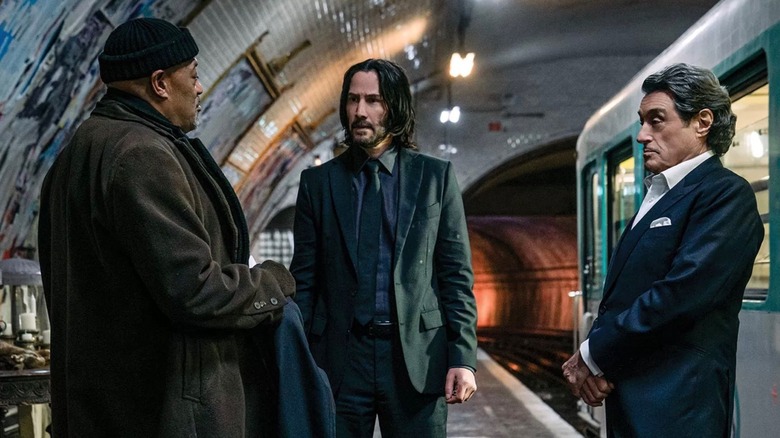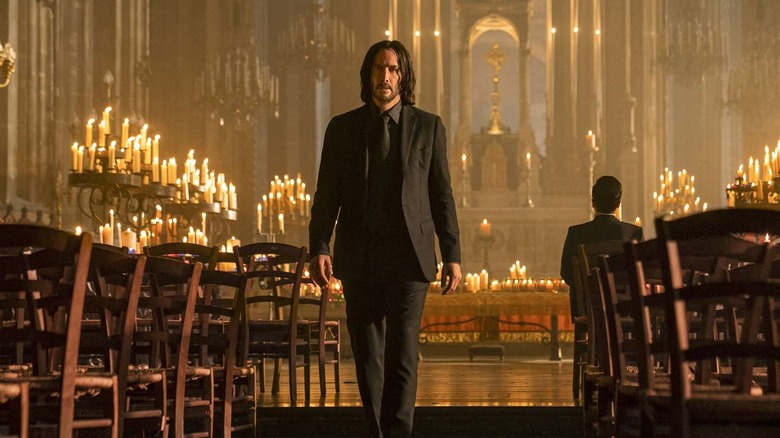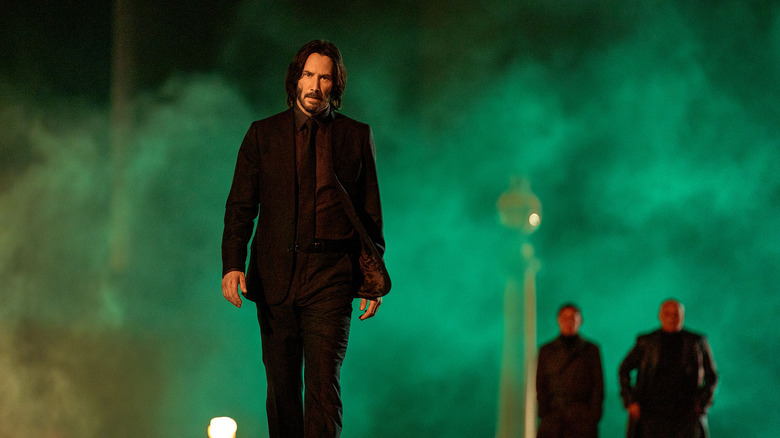
Late in the new film "John Wick: Chapter 4," the grizzled and bloodied eponymous antihero has a simple task in front of him: climb some stairs. But the simplicity of the task is quickly overtaken by a few trifling details. First, he has only a few minutes to make it to the top of the stairs, at which point he will have to take place in a live-or-die duel, which absolutely must occur at sunrise. Second, a seemingly infinite number of men are lying in wait to stop him from reaching the top of the stairs. Third, John has to climb over 200 steps. Oh, and midway through, John is kicked all the way to the bottom of the stairs, making it so he has to climb them twice. This extended sequence is the "John Wick" series in a microcosm: its simplicity is quickly upended, the various bits of combat are visceral and intense because of the precise and coherent action choreography, and it's incredible to behold.
What once started as a simple revenge tale about an ex-assassin getting one up on the Russian mobsters who had the temerity to attack him, steal his car, and kill the dog left behind by his dead wife has morphed into a saga of a man against the world. "John Wick: Chapter 4" is by far the longest entry in the franchise, at 169 minutes, but manages to earn every one of those minutes and the many deaths that occur within them. As lore-heavy as this series has gotten, gradually introducing a world within our own occupied by killers of all stripes across the globe, the story of "John Wick: Chapter 4" is as direct as the original: John Wick wants his freedom, and the only way to do that is to take down the High Table by playing their game.
"Chapter 3 - Parabellum" concluded with a number of balls in the air: John (Keanu Reeves) had been seriously wounded by his old friend/New York Continental manager Winston (Ian McShane), the latter of whom only doing so to ensure that he could retain his status of overseeing the Continental. John was brought to The Bowery King (Laurence Fishburne), who exhorted John to exact revenge against the byzantine High Table, whose unshakable rules had brought each of them so low. As "Chapter 4" begins, John gets a modicum of vengeance by taking down the new Elder of the High Table. The High Table's response — via their new avatar, the Marquis Vincent de Gramont (Bill Skarsgard) — is to demolish the New York Continental. The amoral and sociopathic Marquis wants the very notion of John Wick — not just his abilities but the sense of rebellion he embodies — taken down. The Continental being demolished is only half of the proof that the Marquis means business; the other arrives when he calmly and cruelly kills Winston's dedicated concierge, Charon, played once more by Lance Reddick (whose recent passing only makes his brief scenes all the more poignant). To get rid of John, the Marquis enlists Caine (Donnie Yen), a blind assassin with a personal hook of his own, and also tries to leverage a mysterious Tracker (Shamier Anderson) seemingly willing to take John down for the right, very steep price.
What makes the "John Wick" franchise so special, so intensely exhilarating, and so thrilling are the action setpieces. While the bulk of "Chapter 4" takes place in three locations — Osaka, Berlin, and Paris — the plot often is sidestepped by the massive fight sequences taking place in all three. If any chunk of "John Wick: Chapter 4" could arguably be trimmed to lower the runtime, it would be the section in Berlin, wherein John has to face off against a flamboyant German gangster (played underneath some prosthetics by Scott Adkins). Even this extended scene, which exists so John can have his duel against the Marquis supported by his adoptive Belarusian family of gangsters, includes one of many jaw-dropping stunt falls as well as a colorful and sprinkler-soaked battle between Reeves and Adkins.
Bursting With Sly References

Some of the joy of "John Wick: Chapter 4" is in watching film references play out, as director Chad Stahelski pays homage to a few very unexpected titles among the greatest of all time. At least one of the nods is almost cheerfully shameless: after a brief scene where the Bowery King hypes up an in-training John, he extinguishes a lit match by blowing it out, at which point there's a smash cut to the rising sun somewhere outside Casablanca, a riff on one of the greatest match cuts of all time, from David Lean's "Lawrence of Arabia".
But there are other welcome homages here. (Some of these may be accidental, but considering that "John Wick: Chapter 2" opens with an on-screen reference to Buster Keaton, let's presume otherwise.) In the final hour, as John arrives in Paris for his duel, he's attacked on all sides as the Marquis raises the bounty on his life in the hopes of avoiding the duel entirely. And so, with a sultry French DJ at the top of the Eiffel Tower exhorting all sorts of assassins to get off their duffs and take John down (itself a nod to Walter Hill's "The Warriors"), our antihero drives through the crowded traffic around the Arc de Triomphe, evading both regular drivers and those who wish to do him harm. What starts as a bit of "Let me top this"-style energy from Reeves and Stahelski, inspired perhaps by the scene in "Mission: Impossible - Fallout" featuring Ethan Hunt driving through downtown Paris on a motorcycle, goes deeper. When John is inevitably stopped from using a vehicle and has to get on his own feet, he not only gets into various bone-crunching fights with baddies, but avoids cars zooming around the busy road, calling to mind the underrated comedy "Bowfinger" and a scene in which its co-star Eddie Murphy has to run across a freeway full of very fast-moving traffic. This time, unlike in "Bowfinger," bodies do fall.
Later in Paris, John gets his hands on an ultra-powerful gun with explosive bullets. That John Wick lays waste to a group of bad guys in the middle of a deserted Parisian townhouse should not come as a surprise. The way Stahelski and cinematographer Dan Laustsen shoot and frame the action is where the scene hits a high; calling to mind a birds'-eye view shot in Steven Spielberg's "Minority Report," the camera moves slowly and unwaveringly from room to room as we watch from overhead as John clears the house as much and as fast as possible. It's truly jaw-dropping to behold.
The secret weapon of "John Wick: Chapter 4" is that John isn't the only attraction. There are a number of other impressive figures, from Anderson's flippant bounty hunter to Hiroyuki Sanada as the fiercely determined manager of the Osaka Continental. But best of all is — unsurprisingly — martial arts master Donnie Yen. The script, by Shay Hatten and Michael Finch, does a solid job of making John Wick's fate a true dilemma through the personage of Caine. This blind man is clearly as good at his job as John is and arguably has more to live for, as his musically inclined grown daughter is alive and well in Paris. Aside from the personal touches, what we see of Caine is that he's an immensely talented fighter. Just as Stahelski lets the various fight scenes play out between Reeves and an infinite number of baddies, so too is the case with Yen and the men with whom he does battle. It's to the film's credit that we don't wait long for John and Caine to face off; before John escapes the inner workings of the Osaka Continental in the first third, he's got to do battle with Caine. The ensuing fight is as thrilling as anything in the final hour, with a telling moment where John chooses not to take a kill shot against Caine out of respect.
It's no surprise that the duel at the end of the film, intended to be as old-fashioned as possible, has the Marquis using Caine as his proxy. (Here, too, there is a seemingly brief nod to a classic, Stanley Kubrick's "Barry Lyndon.") But by that climactic moment, it's just as imperative that Caine get out alive as John does, if not more so. As vicious as Caine is — to ensure his daughter's safety, he's willing to kill just about anyone, including Sanada's character in a suitably painful and heart-rending sequence — the final duel is one in which it would be ideal if the only one who died was the Marquis, whose machinations made it happen.
Going Out On A High Note

But of course, we do not live in an ideal world. Though Keanu Reeves isn't quite as old as his fellow ex-teen idol-turned-action hero Tom Cruise (and Cruise has two more "Mission: Impossible" films on the way), Reeves does not shy away from reflecting that John Wick's aging a bit and not always at his fastest. When he muses to Winston and the Bowery King about what he would want written on his tombstone, it's a weighty conversation that sadly pays off. Though Caine and John give as good as they get in the duel from 30 and 20 paces each, at 10 paces, Caine makes the shot that counts. John is alive long enough to a) shoot the Marquis point-blank in the head, having withheld his final shot, and b) be freed of all obligations to the High Table as decreed by the Harbinger (the always-welcome Clancy Brown). But as he has a few final flashes of memories with his late wife Helen, John slumps to his death, and Caine is able to move on to his daughter. (That said, a post-credits scene implies that the daughter of Sanada's manager will not rest until Caine is dead too.)
Could we get a fifth "John Wick"? The last scene before the end credits certainly allows that the door could be open. When the Bowery King wonders aloud if John is in Heaven or Hell, and Winston says dryly, "Who knows?", it raises the slim possibility that John survived his wounds. (On one hand, he got wounded ... a lot. On the other, in this series, if you're not shot in the head, there's a non-zero chance you're alive.) But the possibility that this is the last "John Wick" film featuring John Wick himself— as opposed to films set in the same universe featuring Caine or the upcoming spinoff film "Ballerina" — is perfectly reasonable. John got what he wanted, one way or the other. He's free of the High Table, as he always wanted to be. He doesn't need to keep killing, and if he's passed on, then we don't need to wonder what else he would be fighting for. And if John has to go, he's been removed by an immensely worthy opponent in Caine.
"John Wick: Chapter 4" does not have to say "The End" or include "the final chapter" in its subtitle to feel final. It's okay for a story to end. (If you rewatch the original "John Wick," back before an extended franchise felt remotely possible, you will note that it too feels final.) This story goes out on a high note beyond belief. Even at its extended length, "John Wick: Chapter 4" is an action fantasia like no other. It is a cinematic indulgence whose existence seems as miraculous as the last action film this intense, this relentless, and this darkly perfect, George Miller's "Mad Max: Fury Road". If the idea is to go out on a high note, then "John Wick: Chapter 4" is an unqualified success. This is as good as it gets.
Read this next: The 18 Best Action Movie Actors Ranked
The post John Wick: Chapter 4 Spoiler Review: An Action Fantasia Like No Other appeared first on /Film.

